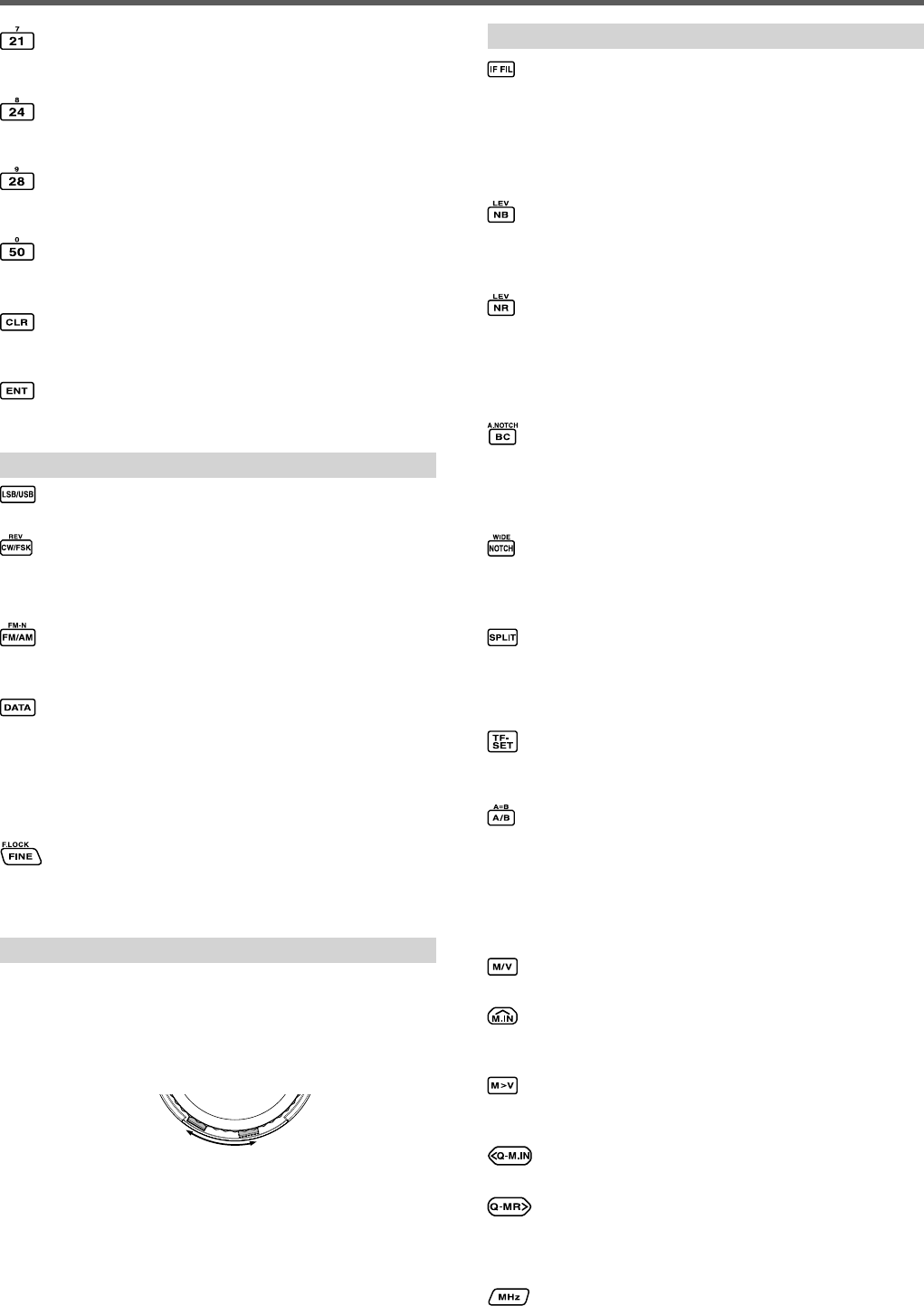
5
GETTING ACQUAINTED 2
[21 (7)]
Press to select the 21 MHz band memory {page 11} or
enter keypad number 7.
[24 (8)]
Press to select the 24 MHz band memory {page 11} or
enter keypad number 8.
[28 (9)]
Press to select the 28 MHz band memory {page 11} or
enter keypad number 9.
[50 (0)]
Press to select the 50 MHz band memory {page 11} or
enter keypad number 0.
[CLR]
Press to exit from, abort, or reset various functions.
Press and hold to clear a memory channel {page 46}.
[ENT]
Press to enter your desired frequency using the
10-key keypad {page 29}.
—— D ——
[LSB/USB]
Press to select LSB or USB mode {page 11}.
[CW/FSK (REV)]
Press to select CW or FSK mode {page 11}. Press
and hold to select a sideband (CW/ CW-R or FSK/
FSK-R).
[FM/AM (FM-N)]
Press to select FM or AM mode {page 11}. Press and
hold to select Narrow FM mode.
[DATA]
Press to select a Data mode (LSB/ LSB-DATA, USB/
USB-DATA, FM/ FM-DATA, or AM-DATA) {page 11}.
In CW mode, Press to toggle the Morse Code
Decoder ON and OFF. Press and hold to enter the
threshold level adjustment mode for Morse Code
Decoder {page 38}.
[FINE (F.LOCK)]
Press to activate the Fine tuning function to allow
more precise tuning {page 30}. Press and hold to
activate the Frequency Lock function {page 56}.
—— E ——
Central (Tuning) control
Turn to select the desired frequency {page 12}. Use
the convenient fi nger-tip cavity for continuous tuning.
Slide the lever underneath the Tuning control to the
left or right to adjust the torque level of the control.
Left makes the control light and right makes it heavy.
light
heavy
TX-RX LED
Lights red while transmitting and green when the
squelch opens while receiving.
—— F ——
[IF FIL]
Press to toggle between IF Filter A and IF Filter B
{page 40}. You can adjust the fi lter bandwidth using
the LO/WIDTH and HI/SHIFT controls. Press and
hold [IF FIL] to momentarily display each setting value
of the current DSP fi lter DSP fi lter bandwidth {page
40}.
[NB (LEV)]
Press to cycle through Noise Blanker 1, Noise Blanker
2, and OFF. Press and hold to adjust the Noise
Blanker level {page 42}.
[NR (LEV)]
Press to cycle through the DSP Noise Reduction
types: NR1, NR2, or OFF {page 41}. When the Noise
Reduction function is turned ON, press and hold
to change the parameters of the Noise Reduction
function {page 42}.
[BC (A.NOTCH)]
Press to select the DSP Beat Cancel function, BC1
(Beat Cancel 1), BC2 (Beat Cancel 2) or OFF
{page 41}. Press and hold to toggle the Auto
Notch Filter ON and OFF {page 41}.
[NOTCH (WIDE)]
Press to toggle the IF Notch Filter ON or OFF
{page 41}. Press and hold to set up the IF Notch
bandwidth {page 41}.
[SPLIT]
Press to enter split-frequency operation, allowing
you to use different transmission and reception
frequencies {page 24}. Press and hold to enter the
Split RX frequency setup mode.
[TF-SET]
During split-frequency operation, press to monitor or
change your transmit frequency {page 24}.
[A/B (A=B)]
Press to select either VFO A or VFO B {page 10}.
Press and hold to duplicate the data in the current
VFO to the other VFO {page 25}. While in Menu
mode, press to select Menu A or Menu B. While in
Program Memory Channel mode, press to recall the
start or end frequency.
[M/V]
Press to toggle between Memory and VFO modes.
[M.IN]
Press to enter Memory Scroll mode and to store data
to a Memory channel {page 43}.
[M>V]
Press to transfer the current Memory Channel
contents to the VFO.
[Q-M.IN]
Press to store data to the Quick Memory {page 46}.
[Q-MR]
Press to recall data from the Quick Memory {page 47},
while in VFO mode. Press to enter Memory Name
Edit mode, while in Memory Channel mode {page 46}.
[MHz]
Press to turn the MHz Up/ Down function ON or OFF.
The MHz digit increases or decreases when you turn
the MULTI/CH control. In Menu mode, press to turn
the Quick Menu ON or OFF {page 14}.


















